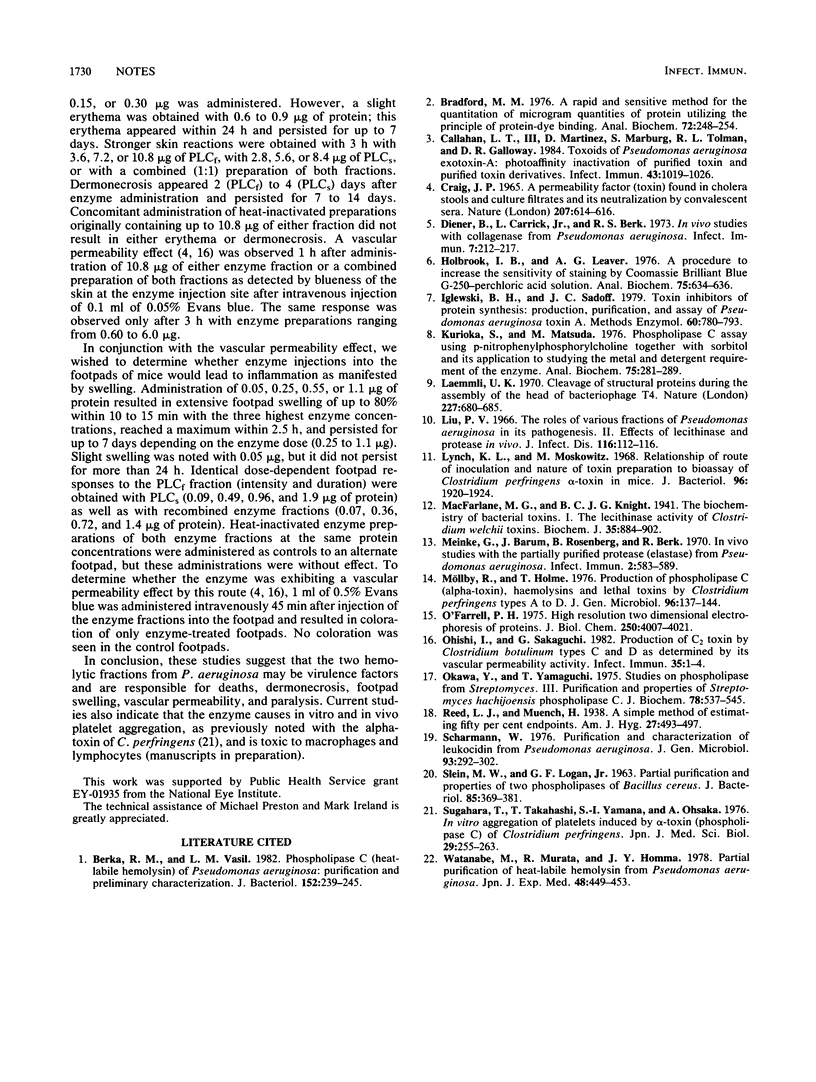Abstract
Two phospholipase C fractions were detected in culture supernatants from Pseudomonas aeruginosa ATCC 19660, PAO1, and D10C by preparative polyacrylamide gel electrophoresis. Both hemolytic fractions from strain ATCC 19660 were isolated by polyacrylamide gel electrophoresis and were found to cause paralysis, death, dermonecrosis, footpad swelling, and vascular permeability in mice. In vivo toxicity was directly associated with enzymatic activity.
Full text
PDF


Images in this article
Selected References
These references are in PubMed. This may not be the complete list of references from this article.
- Berka R. M., Vasil M. L. Phospholipase C (heat-labile hemolysin) of Pseudomonas aeruginosa: purification and preliminary characterization. J Bacteriol. 1982 Oct;152(1):239–245. doi: 10.1128/jb.152.1.239-245.1982. [DOI] [PMC free article] [PubMed] [Google Scholar]
- Bradford M. M. A rapid and sensitive method for the quantitation of microgram quantities of protein utilizing the principle of protein-dye binding. Anal Biochem. 1976 May 7;72:248–254. doi: 10.1016/0003-2697(76)90527-3. [DOI] [PubMed] [Google Scholar]
- Callahan L. T., 3rd, Martinez D., Marburg S., Tolman R. L., Galloway D. R. Toxoids of Pseudomonas aeruginosa exotoxin-A: photoaffinity inactivation of purified toxin and purified toxin derivatives. Infect Immun. 1984 Mar;43(3):1019–1026. doi: 10.1128/iai.43.3.1019-1026.1984. [DOI] [PMC free article] [PubMed] [Google Scholar]
- Craig J. P. A permeability factor (toxin) found in cholera stools and culture filtrates and its neutralization by convalescent cholera sera. Nature. 1965 Aug 7;207(997):614–616. doi: 10.1038/207614a0. [DOI] [PubMed] [Google Scholar]
- Diener B., Carrick L., Jr, Berk R. S. In vivo studies with collagenase from Pseudomonas aeruginosa. Infect Immun. 1973 Feb;7(2):212–217. doi: 10.1128/iai.7.2.212-217.1973. [DOI] [PMC free article] [PubMed] [Google Scholar]
- Holbrook I. B., Leaver A. G. A procedure to increase the sensitivity of staining by Coomassie brilliant blue G250-perchloric acid solution. Anal Biochem. 1976 Oct;75(2):634–636. doi: 10.1016/0003-2697(76)90118-4. [DOI] [PubMed] [Google Scholar]
- Iglewski B. H., Sadoff J. C. Toxin inhibitors of protein synthesis: production, purification, and assay of Pseudomonas aeruginosa toxin A. Methods Enzymol. 1979;60:780–793. doi: 10.1016/s0076-6879(79)60071-x. [DOI] [PubMed] [Google Scholar]
- Kurioka S., Matsuda M. Phospholipase C assay using p-nitrophenylphosphoryl-choline together with sorbitol and its application to studying the metal and detergent requirement of the enzyme. Anal Biochem. 1976 Sep;75(1):281–289. doi: 10.1016/0003-2697(76)90078-6. [DOI] [PubMed] [Google Scholar]
- Laemmli U. K. Cleavage of structural proteins during the assembly of the head of bacteriophage T4. Nature. 1970 Aug 15;227(5259):680–685. doi: 10.1038/227680a0. [DOI] [PubMed] [Google Scholar]
- Liu P. V. The roles of various fractions of Pseudomonas aeruginosa in its pathogenesis. II. Effects of lecithinase and protease. J Infect Dis. 1966 Feb;116(1):112–116. doi: 10.1093/infdis/116.1.112. [DOI] [PubMed] [Google Scholar]
- Lynch K. L., Moskowitz M. Relationship of route of inoculation and nature of toxin preparation to bioassay of Clostridium perfringens alpha-toxin in mice. J Bacteriol. 1968 Dec;96(6):1920–1924. doi: 10.1128/jb.96.6.1920-1924.1968. [DOI] [PMC free article] [PubMed] [Google Scholar]
- Macfarlane M. G., Knight B. C. The biochemistry of bacterial toxins: The lecithinase activity of Cl. welchii toxins. Biochem J. 1941 Sep;35(8-9):884–902. doi: 10.1042/bj0350884. [DOI] [PMC free article] [PubMed] [Google Scholar]
- Meinke G., Barum J., Rosenberg B., Berk R. In Vivo Studies with the Partially Purified Protease (Elastase) from Pseudomonas aeruginosa. Infect Immun. 1970 Nov;2(5):583–589. doi: 10.1128/iai.2.5.583-589.1970. [DOI] [PMC free article] [PubMed] [Google Scholar]
- Möllby R., Holme T., Nord C. E., Smyth C. J., Wadström T. Production of phospholipase C (alpha-toxin), haemolysins and lethal toxins by Clostridium perfringens types A to D. J Gen Microbiol. 1976 Sep;96(1):137–144. doi: 10.1099/00221287-96-1-137. [DOI] [PubMed] [Google Scholar]
- O'Farrell P. H. High resolution two-dimensional electrophoresis of proteins. J Biol Chem. 1975 May 25;250(10):4007–4021. [PMC free article] [PubMed] [Google Scholar]
- Ohishi I., Sakaguchi G. Production of C2 toxin by Clostridium botulinum types C and D as determined by its vascular permeability activity. Infect Immun. 1982 Jan;35(1):1–4. doi: 10.1128/iai.35.1.1-4.1982. [DOI] [PMC free article] [PubMed] [Google Scholar]
- Okawa Y., Yamaguchi T. Studies on phospholipases from Streptomyces. III. Purification and properties of Streptomyces hachijoensis phospholipase C. J Biochem. 1975 Sep;78(3):537–545. doi: 10.1093/oxfordjournals.jbchem.a130938. [DOI] [PubMed] [Google Scholar]
- SLEIN M. W., LOGAN G. F., Jr Partial purification and properties of two phospholipases of Bacillus cereus. J Bacteriol. 1963 Feb;85:369–381. doi: 10.1128/jb.85.2.369-381.1963. [DOI] [PMC free article] [PubMed] [Google Scholar]
- Scharmann W. Purification and characterization of leucocidin from Pseudomonas aeruginosa. J Gen Microbiol. 1976 Apr;93(2):292–302. doi: 10.1099/00221287-93-2-292. [DOI] [PubMed] [Google Scholar]
- Sugahara T., Takahashi T., Yamaya S., Ohsaka A. In vitro aggregation of platelets induced by alpha-toxin (phospholipase C) of Clostridium perfringens. Jpn J Med Sci Biol. 1976 Oct;29(5):255–263. [PubMed] [Google Scholar]
- Watanabe M., Murata R., Homma J. Y. Partial purification of heat-labile hemolysin from Pseudomonas aeruginosa. Jpn J Exp Med. 1978 Oct;48(5):449–453. [PubMed] [Google Scholar]



